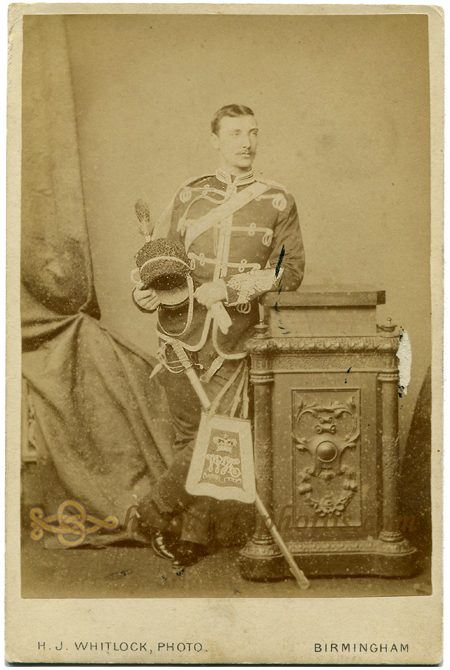This photograph is identified in the
back as "J.B.E.Bourne, 1883".
We learn about Joseph Bennitt Eddis Bourne's life in -surprisingly- the "History
of the bench and bar of Oregon" (Montagu Colmer and
Charles Erskine Scott Wood, 1910)."JOSEPH BENNITT EDDIS
BOURNE.
Residence Rainier, Ore. ; Office, Harrison street, same.
Born May
26, 1858, at Dudley, Worcestershire, England, son of James Samuel
and Ellen Grace (Yates) Bourne. Educated in private school until
fourteen years of age ; then attended Shrewsbury school, in
England. Attended law school in London, Cavalry School at
Aldershot, England, obtaining Field Officer's Certificate in 1883.
Admitted to the bar at London, England, in April, 1881, obtaining
Supreme Court certificate of this date. Practised law in Dudley,
England, until 1886, then he came to Oregon in fall of 1886.
Applied to admission to Oregon bar in 1905, obtaining certificate
of admission dated October 12 of that year. First Lieutenant First
Warwicksire Rifle Volunteers in 1876; Lieutenant in Queen's Own
Worcestershire Yeomanry Cavalry in 1882, and Captain of same in
1883. Municipal Judge in Rainier, 1909-1910. Member of K. of P.
Fraternity ; past member of Junior Army and Navy Club, London,
England. Republican." We can complete that
sketch thanks to the London Gazette : He was gazetted a
Sub-Lieutenant in the 8th Warwickshire Rifle Volunteer Corps on
March 21st, 1876 (dated March 22nd) ; became Lieutenant (dated
22nd March, 1876) on April 9th, 1878 ; when he resigned his
Commission on November 26th, 1880 (dated 27th), he was noted as
belonging to the 2nd Warwickshire Corps. He was gazetted
a Lieutenant in the Queen's Own Worcestershire
Yeomanry on May 30, 1882 (dated 31st).
He would be promoted to the rank of Captain on July
10, 1885 (and not 1883) (dated 11th).
This photograph, dated 1883, shows the officers' uniform post
to the shift of badges of rank to shoulder cords, introduced
c.1880-1881. One will also noticed the newly introduced filet
inside the collar lace. This dress is quite distinctive, with
its four rows only of lace, its 3/4 inch wide silver lace lining,
or the elaborate cuff figure.
We can also see the distinctive regimental Busby and Sabretache.
|

